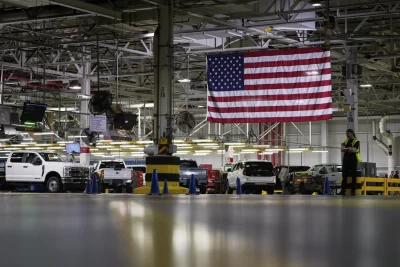
A strike by auto workers against General Motors is expected to cut pretax earnings by $800 million this year, and another $200 million per week after that, the company’s chief financial officer said.
And those figures include only factories that are on strike now, so if more plants are added by the United Auto Workers union, the losses will pile up further, CFO Paul Jacobson told reporters.
The strike is already taking a toll, and shortly after the conference call the UAW expanded the strike to Arlington, Texas, one of GM’s most profitable plants. Five thousand workers walked off their jobs at the factory which makes SUVs.
Shares of General Motors Co. are down more than 13% this year, touching lows Tuesday that haven’t been seen since the pandemic when the company’s sales growth tumbled almost 11% in 2020.
GM on Tuesday posted net income of more than $3 billion from July through September, down 7% from the same period last year due to lost production from the strike, and also increased warranty costs, Jacobson said. The company also withdrew its previous full-year pretax earnings estimates, citing uncertainty over the length of the strike and how many factories would be shut down
The UAW has been on strike since Sept. 15 — nearly six weeks — against GM and its Detroit competitors, Ford and Jeep maker Stellantis. The union had spared factories that make GM’s most profitable vehicles, pickup trucks and large SUVs, from its targeted strikes. Yet the UAW is demonstrating this week that risks to those money-making facilities can rise the longer the strike goes on.
On Monday, the union shut down Stellantis’ huge Ram pickup truck plant north of Detroit in Sterling Heights, Michigan. Two weeks ago workers walked off their jobs at Ford’s largest and most profitable plant, one that makes pickups and big SUVs in Louisville, Kentucky. So far only 28% of the union’s 146,000 members at the Detroit Three are on strike.
Jacobson said the third-quarter strike loss was $200 million, since the walkouts were only in effect the final two weeks of the period. He predicted another $600 million of losses from October through December.
In a note to shareholders, CEO Mary Barra said GM has made a record offer to the union that will raise top factory pay to $40.39 per hour, or roughly $84,000 per year in four years. She indicated that the company is nearing how much it’s willing to pay.
“It’s an offer that rewards our team members but does not put our company and their jobs at risk,” Barra wrote. “Accepting unsustainably high costs would put our future and GM team member jobs at risk, and jeopardizing our future is something I will not do.”
Union President Shawn Fain says the companies are making billions and paying millions to CEOs, so they can afford to pay workers more.
Edward Jones analyst Jeff Windau said investors are concerned about the financial hit from a longer strike, GM slowing electric vehicle production, and whether it can squeeze out more cost cuts to offset a deal with the union.
“Our concern is generally making sure the automakers have that flexibility to be able to navigate through a cyclical downturn,” he said Tuesday.
Jacobson said many have expressed concerns about GM taking on higher labor costs, but the company has planned for it by cutting in other areas. For example, GM’s annual fixed costs will be $2 billion lower than 2022 by the end of 2024, Jacobson said. The company also is slowing electric vehicle production to adjust to slower short-term growth in demand.
Last week GM announced that it’s postponing production at one Michigan electric pickup truck factory from this year until late 2025 to keep manufacturing in line with demand. That decision will save the company $1.5 billion next year, Jacobson said.
Barra said the transition to EVs will be “a bit bumpy” at times, but GM is prepared to react with agility. As an example, she cited the company’s plan to resurrect the Chevrolet Bolt small EV, which the company was to stop making at the end of this year. Now, the company will take the attributes of the current Bolt and add new battery and other technology to roll out a new vehicle in 2025. “It will require a lot less capital” to make the new version, she said, “while leveraging the strong customer enthusiasm we have for the Bolt EV.”
GM is sticking with plans to increase manufacturing capacity to 1 million EVs per year in North America by the end of 2025, he said. But earlier guidance of building 400,000 EVs in North America through the middle of next year have been scrapped. Jacobson said GM still expects to start turning low-to-mid single-digit profit margins on electric vehicles in 2025.







